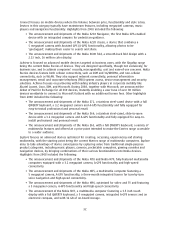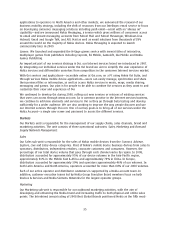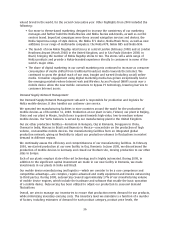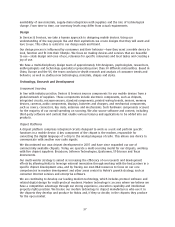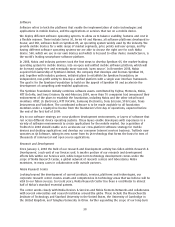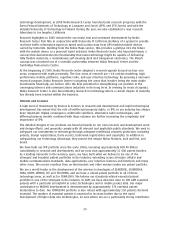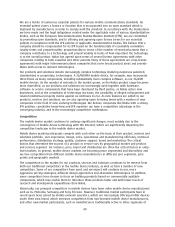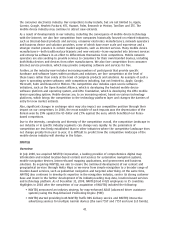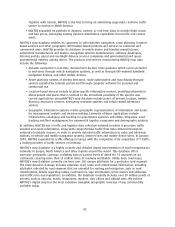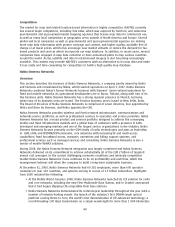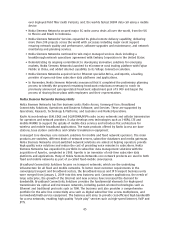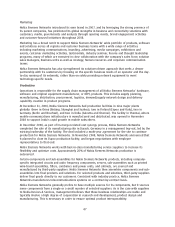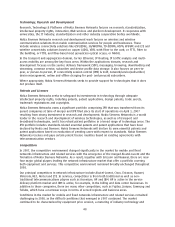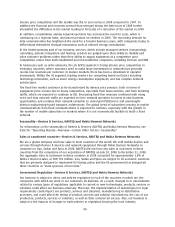Nokia 2008 Annual Report Download - page 41
Download and view the complete annual report
Please find page 41 of the 2008 Nokia annual report below. You can navigate through the pages in the report by either clicking on the pages listed below, or by using the keyword search tool below to find specific information within the annual report.We are a holder of numerous essential patents for various mobile communications standards. An
essential patent covers a feature or function that is incorporated into an open standard which is
deployed by manufacturers in order to comply with the standard. In accordance with the declarations
we have made and the legal obligations created under the applicable rules of various standardization
bodies, such as the European Telecommunication Standardization Institute (ETSI), we are committed
to promoting open standards, and to offering and agreeing upon license terms for our essential
patents in compliance with the IPR policies of applicable standardization bodies. We believe that a
company should be compensated for its IPR based on the fundamentals of reasonable cumulative
royalty terms and proportionality: proportionality in terms of the number of essential patents that a
company contributes to a technology, and proportionality in terms of how important the technology
is to the overall product. Nokia has agreed upon terms of several license agreements with other
companies relating to both essential and other patents. Many of these agreements are crosslicense
agreements with major telecommunications companies that cover broad product areas and provide
Nokia with access to relevant technologies.
Our products and solutions include increasingly complex technology involving numerous patented,
standardized or proprietary, technologies. A 3G/WCDMA mobile device, for example, may incorporate
three times as many components, including substantially more complex software, as our 2G/GSM
mobile devices. As the number of entrants in the market grows, as the Nokia product range becomes
more diversified, as our products and solutions are increasingly used together with hardware,
software or service components that have been developed by third parties, as Nokia enters new
businesses, and as the complexity of technology increases, the possibility of alleged infringement and
related intellectual property claims against us continues to rise. As new features are added to our
products, services and solutions, we are also agreeing upon licensing terms with a number of new
companies in the field of new evolving technologies. We believe companies like Nokia with a strong
IPR position, cumulative knowhow and IPR expertise can have a competitive advantage in the
converging industry, and in the increasingly competitive marketplace.
Competition
The mobile device market continues to undergo significant changes, most notably due to the
convergence of mobile device technology with the Internet, which are significantly impacting the
competitive landscape in the mobile device market.
Mobile device market participants compete with each other on the basis of their product, services and
solutions portfolio, user experience, design, price, operational and manufacturing efficiency, technical
performance, distribution strategy, quality, customer support, brand and marketing. The critical
factors that determine the success of a product or service vary by geographical market and product
and services segment. For instance, price, brand and distribution are often the critical factors in entry
level markets. In general, mobile device markets are becoming more segmented and diversified, and
we face competition from different mobile device manufacturers in different user segments, price
points and geographic markets.
The competition in the market for our products, services and solutions continues to be intense from
both our traditional competitors in the mobile device industry, as well as from a number of new
competitors. Some of our competitors have used, and we expect will continue to use, more
aggressive pricing strategies, different design approaches and alternative technologies. In addition,
some competitors have chosen to focus on building products based on commercially available
components, which may enable them to introduce these products faster and with lower levels of
research and development expenditures than Nokia.
Historically, our principal competitors in mobile devices have been other mobile device manufacturers
such as LG, Motorola, Samsung and Sony Ericsson. However, traditional market participants have in
recent years been joined by mobile network operators, which are increasingly offering mobile devices
under their own brand, which increases competition from nonbranded mobile device manufacturers,
and other new market participants, such as manufacturers traditionally active in other segments of
40




